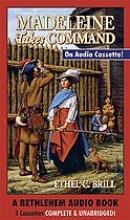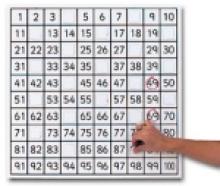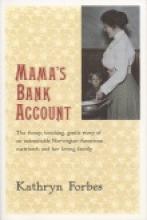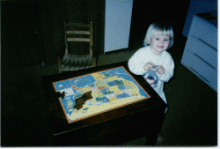No name
Madeleine Takes Command
The thrilling true story of fourteen-year-old Madeleine de Verchères, who in 1692 defended her family's seigneury (a type of fortress) and its occupants from the fierce Mohawk Indians for an entire week with only the aid of her two younger brothers, an elderly servant, one faithful full-grown man and two cowardly soldiers who were of little help. Although the basic outline of the story is well-documented, this story fills in all of the interesting (and likely) details surrounding this event that is still commemorated near Montreal with a statue of this young heroine.
The story is exciting and, while not quite graphic, probably intense enough to make it unsuitable as a read-aloud for very young children. Children beyond fourth grade or so will find it interesting and exciting, with many details of bravery, clever strategies and God's providence.
The story is an excellent supplement for the study of Canadian and/or North American history. The authors portrayal of the interactions with the Indians are quite fair – placing a great deal of the blame for the cruelty of the Indians upon the heads of the white men (both from France and England) many of whom repeatedly betrayed their trust and used them for their own selfish interests.
Highly recommended. Also see our review of the audio version.
Madeleine Takes Command (audio)
The story opens with Madeleine's mother regretfully leaving with her three youngest children to go to Montreal on business. As the oldest child of the seigneur, Madeleine is left in charge of the estate. With the constant threat of raiding Iroquois parties, burning, killing, and destroying, tension builds as Madeleine anxiously awaits her mother's return. Suddenly, while on patrol in the woods, the garrison is attacked and the tenant farmers are either captured or massacred as they make their way to the fields. Madeline, her brothers, an elderly servant, and two useless, cowardly soldiers are left to defend the fort and the remaining wives and children of the workers, who huddle together in the blockhouse.
Through Madeleine's ingenious ideas, they are able to present the appearance of far more militia men defending the fort. Hoping for reinforcements, they must battle against the constant threat of an open assault, as they observe the Iroquois darting in and out of the woods, threatening to do more harm, yet their biggest danger may be their own fatigue from the constant watch.
Who is to blame for all the fighting? The author presents a fair account of the turbulent times, giving blame equally to all sides and prodding the reader to reflect on the true Christian response to war and hatred.
Since this is a recording, the narrator also plays a role in the story. The narrator in this production is a woman with a sweet and soft-spoken voice. Her French pronunciation is impeccable. It is the suspenseful storyline, rather than her presentation; however, that carries the listener's interest. With each new turn of events, my children eagerly anticipated the next chapter. Will the reinforcements come in time to save the fort?
4 Hours (3 Audio Tapes or 4 Audio CDs)
Magellan's World
Magnetic Hundreds Board
This 23" x 23" laminated poster is made by Nasco.
I have used homemade hundreds charts for years - they've been a great help for Math in preschool, kindergarten and early grade school. I was so excited when I saw this item in a catalog because it is advertised as a "double-sided wipe-off white board with sheet magnet-receptive surfaces." I immediately dreamed up all sorts of fun things my little ones could do on this board with skip-counting, covering numbers, etc.
I was immediately disappointed in the quality of the board. It really is more of a thick poster than a board. It seems to be made of two cardstock poster-sized sheets with a thin metallic sheet in between. The three sheets are laminated together with a rather thin laminate (I honestly couldn't tell at first if this was the packaging to be removed - it wasn't!). Nevertheless, I decided to give it a try and hung it on the wall. My first grade daughter very happily proceeded to draw x's over all of the even numbers (this was fun!). We discovered soon afterwards that our markers (Expo2 dry erase markers) would not erase from this board. We tried two different kinds of dry-erasers, a special dry-erase board spray and finally windex and paper towels.
I want to make clear that Customer Service at Nasco was very easy to deal with in getting my money refunded. But this is a product I recommend avoiding.
Make Way for Ducklings
Making Music Praying Twice
Making Things Right - The Sacrament of Reconciliation
Mama's Bank Account
When I first proposed to read this story aloud to my children, my oldest, then perhaps 8 or 9 years old, protested loudly! She thought it was going to be a series of numbers and notes about expenditures that I was going to read to her. It only took a little persuading and a few pages before she was hooked. This is a true story - really a set of simple reminiscences - about a Norwegian immigrant family living in San Francisco in the early 1900s (somewhere between the 1906 earthquake and World War I). The stories center around the author's mother, "Mama" - a wonderful character who is difficult to describe with just a few quick adjectives. This is partly because the author reveals her mother's character through favorite family stories in a lovely, subtle way (with plenty of laugh-out-loud spots!). You come to see that Mama is shrewd but completely selfless; she has a wonderful grasp of human nature, but is easily misunderstood (by friends, relatives or readers of the book) because she so readily sees what is good in everyone; she is quiet, but oh, SO stubborn and certainly knows how to get things done in spite of insurmountable odds! Looking through Mama's eyes at the interesting characters that come into her life is a wonderful experience and one you shouldn't miss. Here's a little part of a story to give you a little sense of the book. A boarder, Mr. Hyde, has lived with their family for some time and enthralled all of them by reading classic novels aloud to them every night.
Even when the warm weather came we children didn't beg to go out in the evenings to play one-foot-off-the-gutter. I think Mama was glad; she never liked us running the streets. Best of all, Nels went less and less to the street corner to hang around with the neighborhood boys. The night they got into trouble for breaking into Mr. Dillon's store Nels was home with us. He'd wanted to hear the last chapter of Dombey and Son. Mr. Hyde had taken us deep into Ivanhoe when he got the letter. "I must go," he told Mama. "I shall leave the books for Nels and the children. Here is my check for all I owe you, madam, and my profound thanks for your hospitality." We were sorry to see Mr. Hyde leave, but it was with great excitement that we brought his books out into the kitchen. There were so many of them! We read some of the titles: A Tale of Two Cities, Nicholas Nickleby, Vanity Fair, The Adventures of Alice in Wonderland, Oliver Twist, A Midsummer Night's Dream. Mama dusted them reverently. "So much we can learn," she said. Nels, she added, could read aloud to us each evening, just as Mr. Hyde had done, because Nels too had a fine voice. I could see that made him very proud. Mama showed Mr. Hyde's check to Aunt Jenny. "You see?" she said. "The warm coat I shall have after all." It was too bad that Aunt Jenny was still there when Mr. Kruper came. Mr. Kruper owned the restaurant and bakery down the street and he was angry. "That man Hyde was a crook!" he shouted. "Look at this check he gave me. It's no good! The bank people tell me he cashed them all over the neighborhood." Aunt Jenny's triumphant nod said as plainly as words - I told you so! "I'll bet he owes you folks plenty, too, eh?" Mr. Kruper asked. Mama looked around at all of us. Her eyes rested longest on Nels. "Read," she told him gently, "read to us from Ivanhoe." Then she walked to the stove and put the check into the flames. "No," she answered Mr. Kruper. "No. He owes us nothing."
I think this is best as a solo read for the 12 and up crowd, though it could be read aloud - perhaps with a little explanation or discussion along the way - to children much younger. If you've ever seen the movie I Remember Mama (1948) with Irene Dunne, you're already acquainted with the main characters of this lovely little book. If you haven't seen it yet, you're missing out on a real treasure that could be enjoyed before or after this book. But that's a matter for a separate review.
Copyrights 1943/1971









